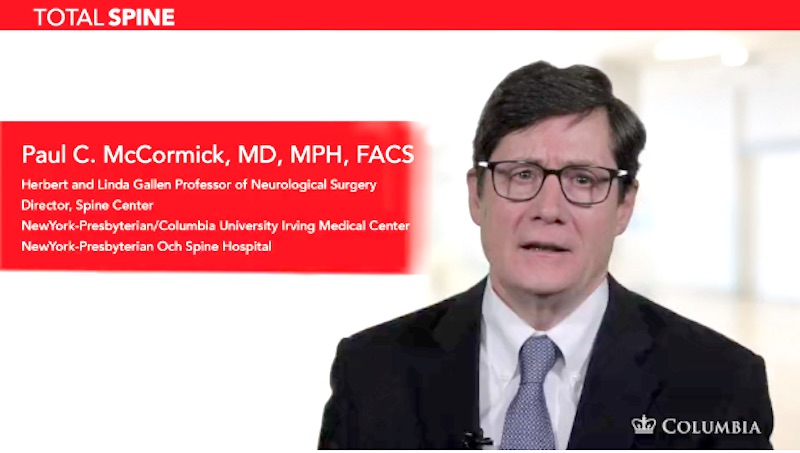| Header | Text |
| What is an Anterior Cervical Discectomy? | A discectomy is a procedure that removes a damaged, arthritic, or herniated intervertebral disc (the “cushion” between adjacent bones of the spine). An anterior surgical approach means an approach from the front of the body, and the cervical spine is the spine in the neck. So an anterior cervical discectomy is a procedure that removes a damaged intervertebral disc from the spine in the neck, using a surgical approach from the front of the neck.
An anterior cervical discectomy is often performed along with procedures called fusion and fixation to ensure spinal stability. A fusion is the implantation of a bone graft that will fuse (grow together) with vertebrae (bones of the spine) in the area. A fixation is the implantation of screws, rods or plates. A fixation is a common way to hold the bones in place while they fuse. An Anterior Cervical Discectomy and Fusion is often abbreviated ACDF.
In some patients an artificial disc, or arthroplasty, is utilized instead of a fusion once the damaged disc has been removed. Younger patients and those with normal motion of the cervical spine are the most appropriate candidates for cervical artificial disc replacement.
An anterior cervical discectomy is similar to a related procedure called an anterior cervical corpectomy, and the two surgeries may be used to treat similar conditions. The difference is that a corpectomy is a more extensive procedure, typically used when the disease extends beyond the areas than can be dealt with through a discectomy. In a discectomy, only the damaged portion of a disc and bone spurs are removed, whereas in a corpectomy, the vertebrae (bone of the spine) are also removed.
|
| When is this procedure performed? | Anterior cervical discectomy is performed for patients who have experienced changes such as degeneration and bone spurs (growth of bony projections) in the discs of the cervical spine, and for those with herniated discs.
These conditions can affect the amount of space available for the spinal cord and nerves. As a result, the spinal cord and nerves can become compressed (pinched), and even injured.
Before surgery is considered, the doctor may recommend nonoperative measures such as pain medications and physical therapy.
Surgery is typically the recommended treatment when the spinal cord is at risk of damage. Surgery may also be warranted for those patients who do not find relief with nonoperative treatment.
An anterior cervical discectomy, like any surgical procedure, is associated with a certain amount of risk. However, this risk is usually small. Recommendations vary by case, and a neurosurgeon will be able to explain the risks and benefits of the procedure for any individual case.
|
| How is this procedure performed? | This procedure is performed under general anesthesia.
The surgeon first makes an incision on the front of the neck, then moves aside soft tissues to expose the anterior spine. The surgeon removes the damaged disc(s) and any bone spurs to remove the pressure from the spinal cord or nerve roots. This part of the procedure is often performed with an operating microscope, using microsurgical neurosurgical techniques.
Next, the surgeon may perform either a spinal fusion and fixation to ensure the spinal column is well-aligned and stable, or an arthroplasty in which the disc is replaced by an artificial cervical disc. To perform a spinal fusion, the surgeon replaces the disc with a bone graft taken from the patient’s own body or from a bone bank. The surgeon then implants a titanium plate and screws to fix the bones (hold them in place). The implantation of titanium hardware (the fixation) provides spinal stability as the bone graft fuses (grows together) with the adjacent bones. Once the bones have fused, the spine is stable. If an arthroplasty is performed, the surgeon will select the appropriate size artificial disc and implant it into the disc space. Both fusion and arthroplasty are performed under direct vision of the surgeon and verified with intraoperative X-rays to ensure precise placement.
The incision is closed with sutures underneath the skin and dressed with a small gauze bandage.
|
| How should I prepare for this procedure? | Make sure to tell your doctor about any medications that you’re taking, including over the counter medication and supplements, especially medications that can thin your blood such as aspirin. Your doctor may recommend you stop taking these medications before your procedure. To make it easier, write all of your medications down before the day of surgery.
Be sure to tell your doctor if you have an allergy to any medications, food or latex (some surgical gloves are made of latex).
On the day of surgery, remove any nail polish or acrylic nails, do not wear makeup and remove all jewelry.wigs/hairpiece. Also, you will need to remove contact lenses, eyeglasses, and dentures.
If staying overnight, bring items that may be needed, such as a toothbrush, toothpaste, and dentures.
|
| What should I expect after the procedure? | How long will I stay in the hospital?
Patients are usually discharged from the hospital the day after surgery. The surgeon will schedule a follow up visit, typically 4-6 weeks after surgery. At the follow up visit, the surgeon will take X-rays to monitor your bones and see how they are healing.
Will I need to take any special medications?
The surgeon will typically prescribe oral pain medications to be taken at home.
For patients who have had an arthroplasty, the surgeon may prescribe aspirin to be taken on a daily basis for two weeks following the surgery. This helps limit the possible growth of calcium around the artificial disc.
Will I need to wear a collar?
The fixation provides immediate stability, so a collar may not be required. The surgeon will determine if you would benefit from using a collar.
When can I resume exercise?
Patients are usually encouraged to increase their activities as they are able to tolerate, but should refrain from strenuous or high-impact exercise until cleared by the surgeon. It may be several weeks to a few months before rigorous activities can be resumed.
Will I need rehabilitation or physical therapy?
Physical therapy that focuses on the neck may commence at either 6 or 12 weeks following the surgery, once the bone graft is sufficiently healed. Patients with artificial disc replacement will be allowed to resume full activity at an earlier time.
Will I have any long-term limitations due to an anterior cervical discectomy?
There are no long-term limitations due to this procedure.
Is there anything else I should know?
For patients who have had a fusion, we would recommend refraining from anti-inflammatory agents for 3 months. We would also recommend waiting 3 months for any elective medical procedures (e.g. dental work, other elective surgery). Feel free to contact your surgeon’s office if you have any questions.
|
| Preparing for your appointment | Drs. Paul C. McCormick, Michael G. Kaiser, Peter D. Angevine, Alfred T. Ogden, Christopher E. Mandigo, Patrick C. Reid and Richard C.E. Anderson (Pediatric) are experts in anterior cervical discectomy.
|


